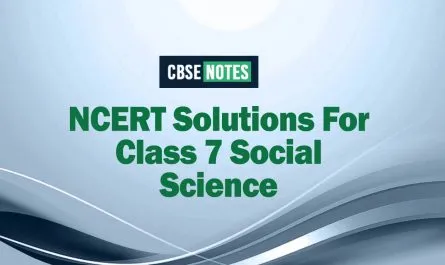NCERT Solved Exercise Questions – Class 11 Biology Chapter 16 Digestion and Absorption
16.1. Choose the correct answer among the following :
(a) Gastric juice contains
(i) pepsin, lipase and rennin
(ii) trypsin, lipase and rennin
(iii) trypsin, pepsin and lipase
(iv) trypsin, pepsin and renin
(b) Succus entericus is the name given to
(i) a junction between ileum and large intestine
(ii) intestinal juice
(iii) swelling in the gut
(iv) appendix
Ans – (a) (i) Pepsin, lipase and rennin (b) (ii) Intestinal juice
16.2. Match column I with column II
Column I Column II
(a) Bilirubin and biliverdin (i) Parotid
(b) Hydrolysis of starch (ii) Bile
(c) Digestion of fat (iii) Lipases
(d) Salivary gland (iv) Amylases
Ans – Column I Column II
(a) Bilirubin and biliverdin (ii) Bile
(b) Hydrolysis of starch (iv) Amylases
(c) Digestion of fat (iii) Lipases
(d) Salivary gland (i) Parotid
16.3. Answer briefly:
(a) Why are villi present in the intestine and not in the stomach? (b) How does pepsinogen change into its active form?
(c) What are the basic layers of the wall of alimentary canal? (d) How does bile help in the digestion of fats?
Ans – (a) Microvilli significantly improve the small intestine’s absorptive surface area, and since the small intestine is where most digested food is absorbed relative to other organs, villi are found there rather than in the stomach. The temporary storage of food is another function of the stomach.
(b) The proenzyme pepsinogen, which is released by oxyntic cells of the gastric glands, is transformed into the active enzyme pepsin, the proteolytic enzyme of the stomach, when it is exposed to hydrochloric acid.
(c) There are four layers in the wall of the alimentary canal from the oesophagus to the rectum: serosa, muscularis, sub-mucosa, and mucosa. The outermost layer, known as the serosa, is composed of a thin mesothelium and some connective tissues. The loose connective tissues that make up the sub-mucosal layer contain lymph, blood, and nerve vessels. Additionally, sub-mucosal glands can be found in the duodenum. The mucosa is the innermost layer lining the alimentary canal lumen.
(d) Although bile lacks enzymes, it does contain bile salts such as sodium bicarbonate, sodium glycocholate, and sodium taurocholate that break large fat droplets into numerous smaller ones by reducing their surface tension, a process known as emulsification. These tiny fat droplets provide lipase, an enzyme that breaks down fat, with a lot of surface area.
16.4. State the role of pancreatic juice in digestion of proteins.
Ans – Inactive enzymes like trypsinogen, chymotrypsinogen, and procarboxypeptidases are found in pancreatic juice. Enterokinase, an enzyme released by the intestinal mucosa, converts trypsinogen into active trypsin, which in turn triggers the activation of further pancreatic enzymes. The proteolytic enzymes of pancreatic juice break down the proteins, proteases, and peptones in the chyme.

16.5. Describe the process of digestion of protein in stomach.
Ans – Gastric glands located in the mucosa of the stomach release mucus, proenzyme pepsinogen, HCl, and intrinsic factor. In order for vitamin B12 to be absorbed, intrinsic factor is necessary. The chyme, the stomach’s acidic gastric fluids that the meal fully combines with. When exposed to HC1, the proenzyme pepsinogen becomes the active enzyme pepsin. Proteins are changed into proteases and peptones by pepsin. Renin, which is present in newborns’ stomach juice, aids in the breakdown of milk protein.

16.6. Give the dental formula of human beings.
Ans – The dental formula of human beings is

It displays how the teeth are arranged in the upper and lower jaws, respectively.

16.7. Bile juice contains no digestive enzymes, yet it is important for digestion. Why?
Ans – Bile pigments (bilirubin and biliverdin), bile salts, cholesterol, and phospholipids but no enzymes are present in the bile juice that is discharged into the duodenum. Bile aids in the breakdown of lipids into tiny micelles, or in the emulsification of fats. Lipases are also activated by bile. Bile is acidic (pH about 8). Feces include bile pigments that are expelled. The aforementioned processes won’t take place without HCl, which will influence food digestion.
The HCl in gastric juice has the potential to harm the underlying blood vessels and result in gastric or duodenal ulcers. These result in internal bleeding. Stressful situations also result in the production of strong HCl. HCl and intrinsic factor are secreted by parental or oxyntic cells.
16.8. Describe the digestive role of chymotrypsin. Which two other digestive enzymes of the same category are secreted by its source gland?
Ans – Proteins are converted into peptides by chymotrypsin, and milk protein is converted into paracasein (curd). Trypsinogen, chymotrypsinogen, procarboxypeptidases, amylases, lipases, and nucleases are inactive enzymes found in pancreatic juice. Enterokinase, an enzyme released by the intestinal mucosa, converts trypsinogen into active trypsin, which then causes the other enzymes in the pancreatic juice to become active.
Proteases and peptones are converted into peptides and amino acids by trypsin. Peptides are converted into smaller peptides and amino acids by procarboxypetidases. Maltose is produced from starch by amylases. Emulsified fat is converted by lipases into fatty acids and glycerol. Nucleases convert nucleotides into bases composed of phosphate, sugar, and nitrogen.
16.9. How are polysaccharides and disaccharides digested?
Ans – Starch and glycogen are two polysaccharides that are first broken down in the buccal cavity. Salivary amylase or ptyalin reacts with polysaccharides in the buccal cavity to break down starch and glycogen into disaccharides and tiny dextrins known as “a” dextrin.
Due to the lack of carbohydrase in gastric juice, digestion of carbs does not take place in the stomach.
Pancreatic juice and intestinal juice combine with the food in the small intestine. Pancreatic amylase is a carbohydrase found in pancreatic juice. More starch and glycogen are hydrolyzed by this enzyme.
The carbohydrases maltase, isomaltase, a-dextrinase, sucrase, and lactase found in intestinal juice operate on disaccharides in the following ways:

16.10. What would happen if HCl were not secreted in the stomach?
Ans – Parietal or oxyntic cells of the stomach glands release HCl. It does the following things:
- It converts prorennin and pepsinogen into their active forms, pepsin and rennin, respectively.
2. It offers the ideal pH for pepsin, which is an acidic 1.8.
3. It eradicates dangerous microorganisms that are present in the diet.
4. It halts saliva’s impact on food. The two main stomach proteolytic enzymes are pepsin and rennin. Protein digestion in the stomach won’t occur if these enzymes aren’t activated by HCl, and dangerous bacteria can still spread various diseases.
16.11. How does butter in your food get digested and absorbed in the body?
Ans – The saturated fat in butter is. Triglycerides are the fats and oils found in the food we eat.
These are broken down by lipases. The main organ for digesting fat is the small intestine.
Three alkaline secretions—bile, pancreatic juice, and intestinal juice—meet food in the small intestine.
Although bile is devoid of enzymes, it does include bile salts that break up larger fat droplets by lowering their surface tension (emulsification).

triglycerides emulsified The main enzyme for breaking down fats is found in pancreatic juice, which is called pancreatic lipase. Bile triggers its activation.
The last products of fat digestion include fatty acids, glycerol, and monoglycerides, which are not directly absorbed from the contents of the intestine due to their insoluble nature in water. Micelles are created as a result of their fusion with bile salts and phospholipids (water soluble). Fatty acids, glycerides, sterols, and fat-soluble vitamins are taken up into the intestinal cells by diffusion from the micelles, where they are resynthesised in the ER and transformed into incredibly tiny protein-coated fat molecules (droplets) called chylomicrons. These latter substances are expelled from intestinal cells and absorbed by lacteal lymph, which is a type of lymph. Finally, the ingested compounds are released into the bloodstream by these lacteals.
16.12. Discuss the main steps in the digestion of proteins as the food passes through different parts of the alimentary canal.
Ans – Proteases convert ingested food’s proteins into amino acids (peptidases). Proenzymes, which are the inactive versions of proteases that are secreted, are transformed into active proteases at the location of their activity. The small intestine is where protein digestion is finished after beginning in the stomach. Protease is absent from saliva.

Protein digestion in the stomach: Pepsinogen and prorennin are secreted by the stomach gland’s primary cells.

Protein digestion in the small intestine: Enzymes from intestinal and pancreatic juice interact with peptones and proteases in the small intestine.
Trypsinogen, chymotrypsinogen, and pro-carboxy peptidase are three inactive proteases that are present in pancreatic juice.
amino acids plus dipeptides Two digestive pro-teases, amino peptidases and dipeptidases, as well as a nondigestive enterokinase, are present in intestinal juice (enteropep- tidase).
16.13 Explain the term thecodont and diphyodont.
Ans –Thecodont: Each tooth in a human is encased in a jawbone socket. The term “thecodont” refers to such teeth.
Diphyodont: During their lifetime, most mammals, including humans, develop two sets of teeth: a set of temporary milk or deciduous teeth that are replaced by a set of permanent or adult teeth. Diphyodont is the name for this kind of dentition.
16.14 Name different types of teeth and their number in an adult human.
Ans – adult human has 32 teeth.
The heterodont dentition, or four separate types of teeth, exists in humans. Following are the various tooth kinds found in humans: canines = 4, premolars = 8, and molars = 12 for the incisors.
16.15 What are the functions of liver?
Ans – Hepatic cells make up the largest gland in the body, the liver. The liver serves the body in a variety of ways outside only as a digestive organ. Its numerous uses include the following.
- Bile secretion
- The processes of glycogenolysis, gluconeogenesis, and glycogenesis.
- The storage of fat, glycogen, A, D, E, K, B12 vitamins, blood, water, etc.
- Amino acid deamination.
- The creation of urea.
- The removal of excretory materials.
- The removal of dangerous substances.




